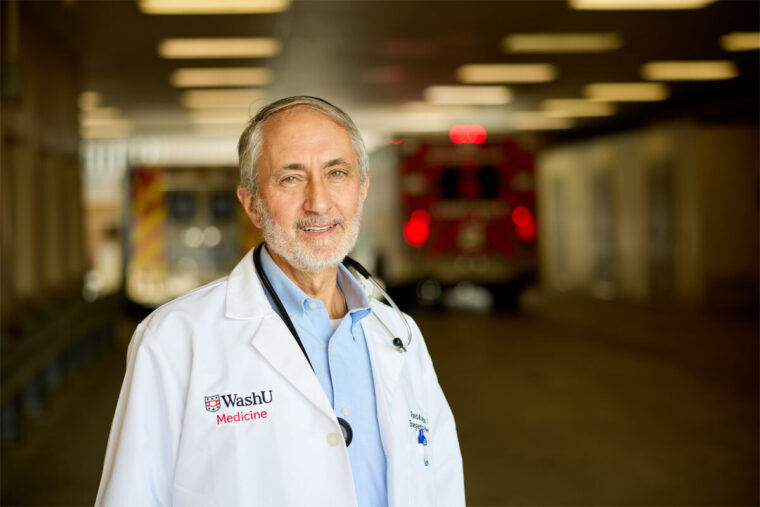
Each day, some 200 to 300 patients arrive at the Barnes-Jewish Hospital emergency department seeking care - many in pain, all in search of answers, healing and hope. Amid the constant motion and intensity, WashU Medicine physician Randall Jotte, MD, brings something else: a quiet steadiness and a lift in spirits. On a recent rainy Thursday, security staff at the entrance came in to chat with him, and triage nurses waved and smiled as he made his way through the exam areas, with a pause to check on how a patient-services concierge, new to the department, was enjoying her second shift of work.
Jotte's warmth and equanimity have been assets over his 24 years - filled with unpredictable days - in the Barnes-Jewish emergency department. Still, he acknowledges that there are moments that throw him off balance, including one in October 2012 that changed the trajectory of his work in emergency care.
He had been asked by the then-chief of emergency medicine to develop a practical care-management plan for a middle-aged and unhoused man with chronic blood clots in his lungs. Records gathered by the chief resident at the time showed that the patient had been admitted to Barnes-Jewish and several other local hospitals 76 times over the previous two and a half years; no one knew why. To begin to puzzle it out, Jotte created a color-coded calendar that tracked the days of inpatient stays at different hospitals over a three-month period. He was incredulous at the result.
"It looked like a baseball team's schedule, where there's different colors for home and away games - he was three days here, three days there, five days here, seven days there," Jotte said. "We realized that this patient was living at hospitals."
Very little about the patient's health conditions or his care plan had changed despite hundreds of hospital stays over the previous decade, during which he had amassed a collection of diagnostic tests and CT scans, all with largely the same results. Visits like these can place a burden on the health-care system, in part because balancing resources for patients whose care could be better resolved in non-emergency settings can mean that other patients might have to wait longer for care. For Jotte, this case was an opportunity that pointed to a new way of thinking about the care unhoused patients need.
"That patient was the one who made me start digging into this problem," said Jotte. "In emergency care, you typically see patients for a short amount of time so it's hard to really know what's going on with patients in their everyday lives. We rarely have the opportunity to change how we think about delivering their care - but this was an opportunity for a change."
New approaches for 'familiar faces'
For Jotte, this experience was the genesis of Hospital to Housing, an innovative program launched in May 2019 that aims to improve medical outcomes and reduce costs by providing housing support to stabilize the lives of some frequent users of the emergency room. The program, primarily funded by The Foundation for Barnes-Jewish Hospital, has transformed the lives of vulnerable patients and reduced medical costs. Data from the pilot phase of the project showed that emergency room visits by participants were reduced by 53% and inpatient stays were reduced by 42%. The estimated savings for Barnes-Jewish was $12,500 per participant. Over 70 people have gone through the program since its inception.
The program could not have happened without looking into the larger context of the patient's story.
Kelly Hanselman, the director of emergency services at Barnes-Jewish, said that "familiar faces" - patients who visit the emergency room far more than typical patients - sometimes show up a few times a month; others might visit a few times a day. Some may have home lives where they are subject to violence or abuse. Others are living with mental illnesses or substance use disorders, which can lead to or exacerbate chronic health problems.
For these latter patients, Jotte is often the go-to physician to treat them. And he consciously works to incorporate his expertise with this population into his training of WashU Medicine students and residents.
"He has a smile that makes patients feel like they can tell him anything, and he is really willing to listen, no matter how long the story is," said Arrianna Thompson, MD, a former clinical fellow in the Department of Emergency Medicine, now practicing in Milwaukee. She volunteered with Street Medicine St. Louis to provide medical outreach for unhoused people in the city and frequently worked with Jotte in the emergency department.
Read the full story on the WashU Medicine website.






